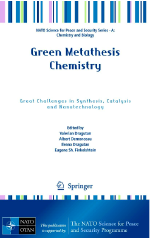"Ruthenium-Arene Complexes Derived from NHC · CO2 and NHC · CS2 Zwitterionic Adducts and Their Use in Olefin Metathesis"
Lionel Delaude and Albert Demonceau
 |
title: Green Metathesis Chemistry
Great Challenges in Synthesis, Catalysis and Nanotechnology
series: NATO Science for Peace and Security
Series A: Chemistry and Biology
editors: Valerian Dragutan, Albert Demonceau,
Ileana Dragutan, Eugene Sh. Finkelshtein
publisher: Springer
city: Dordrecht
year: 2010
first page: 71
last page: 88
isbn: 978-90-481-3431-1 (Print) 978-90-481-3433-5 (Online)
doi: 10.1007/978-90-481-3433-5_7
|
Abstract: A range of imidazol(in)ium-2-carboxylates or -dithiocarboxylates bearing alkyl or aryl groups on their nitrogen atoms were prepared by reacting the corresponding N-heterocyclic carbenes (NHCs) with either carbon dioxide or carbon disulfide. All the zwitterionic products were characterized by various analytical techniques, including thermogravimetric analysis (TGA). Their ability to act as NHC ligand precursors for in situ catalytic applications was investigated in the ruthenium-promoted ring-opening metathesis polymerization (ROMP) of cyclooctene. Upon exposure to the [RuCl2(p-cymene)]2 dimer, the NHC · CO2 adducts readily dissociated to generate [RuCl2(p-cymene)(NHC)] complexes that were highly active catalyst precursors for olefin metathesis. Conversely, the NHC · CS2 betaines retained their zwitterionic nature and led to new cationic complexes of the [RuCl(p-cymene)(NHC · CS2)]+ PF6- type that were devoid of any significant catalytic activity in the reaction under consideration.
Keywords: Arene, Betaines, Cyclooctene, Ring-Opening Metathesis Polymerization, Ruthenium
[Full Text] [<< Previous Book Chapter] [Back to the List of Publications] [Next Book Chapter >>] l.delaude@ulg.ac.be